Leila Marie Lawler's Blog, page 47
August 26, 2016
Unspontaneity ~ The Spirit of the Liturgy, A Book Club
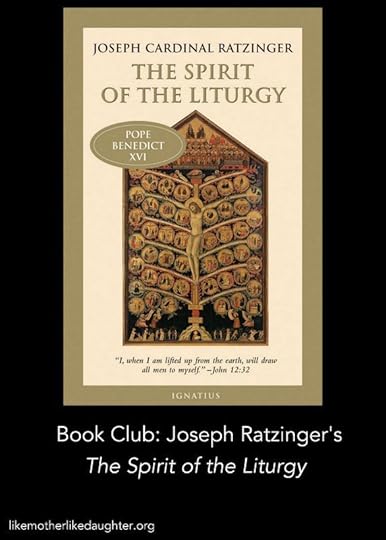
{Book Club: The Spirit of the Liturgy}
I hope you will read along in this book club (or just read my posts, that’s okay): Joseph Ratzinger’s The Spirit of the Liturgy.
(When you buy something via our Amazon affiliate link, a little cash rolls our way… just a little. Thanks!)
I’ll post on Fridays, although for this longer book, perhaps not every Friday. I’ll give you your homework, I’ll talk about what we read, we’ll discuss in the comments. Even if you read later, the comments will still be open.
Previously:
Introduction to the reading: Joseph Ratzinger’s The Spirit of the Liturgy: A Book Club for Easter and Beyond
Nature or history in worship? Or both?
The Relationship of the Liturgy to Time and Space: preliminary questions
The Reservation of the Blessed Sacrament
Homework: Read Chapter Two of Part IV: The Body and the Liturgy — it’s the last chapter!
Chapter One, Part IV: Rite
Here is a word, coined, I think, by Joseph Ratzinger in this chapter, that could not seem more negative to Western ears:
Unspontaneity.
Last week, in the chapter on music, I touched on something mentioned by Joseph P. Swain in his book, Sacred Treasure: the most common musical style employed in today’s churches (both Catholic and Protestant), fastened on with unseemly haste in the 60s, has the quality of spontaneity as its fundamental goal.
This music is actually an accurate expression of what liturgists* think about worship — that it ought to give the impression of having burst forth as an unpremeditated event.
*Begging the question of whether “liturgist” ought to be, in the light of the goal of spontaneity, a thing at all, much less administered, paradoxically, by professionals from a stance of technique, like management or aerospace engineering.
Very rarely does Ratzinger display any emotion as he writes, but in his book The Feast of Faith, he focuses on this rather ridiculous approach:
… The opinion is all too widely held today that so-called creativity, the active participation of all present, and the relationship to a group in which everyone is acquainted with and speaks to everyone else are the real categories of the conciliar [modern] understanding of the liturgy. Not only assistant pastors but even some bishops think they are not being faithful to the Council of they pray everything just the way it is found in the Roman Missal; at least one “creative” formulation must be inserted, regardless of how trite it may be. And the conventional greeting of the congregation at the beginning along with friendly wishes at the dismissal have already become obligatory elements of the sacred action, which hardly anyone would dare omit.*
I hope you appreciate the way this last sentence fairly drips with ironic juices.
Yes, all those embellishments meant to convey hearty camaraderie and a sense of being above “all that stuffy rigid formality” — like celebrities’ “unscripted,” ubiquitous waves to friends as they mount the podium; the “unstudied” smiling acknowledgement accompanied by the jaunty pointed finger, picking out the special one in the crowd; the “unrehearsed” quick departure from the written text, noted on the teleprompter — have become as entrenched and as sacrosanct as any other ritual.
*Protestants don’t have a Council, but they have their modern pieties as well. Simply consider the rigid pattern that “spontaneous prayer” follows… so much so, that it can easily be spoofed with deadly accuracy.
So we must examine our rituals.
In this chapter, Ratzinger clearly has the whole of Guardini’s work in mind. But he’s trying to give context for Guardini’s philosophical guidelines.
As always in both the books, the question “What is liturgy; that is, what is worship — what is its spirit?” is front and center. For Ratzinger, as he stated at the start, the key answers are in Scripture and in history. Having prepared the ground with the previous chapters, in this one he comes squarely to the nub: the importance of rite.
To adapt a saying of Kant, liturgy “covers everything” from the Incarnation to the Resurrection, but only on the way of the Cross. For Christians, then, “rite” means the practical arrangements made by the community, in time and space, for the basic type of worship received from God in faith. (P. 160)
I will leave it to you to follow his outline of ritual in the East, with its sense of the givenness of worship, and West, with its creativity anchored in time and place (p. 163), growing organically. Note especially his emphasis on the many and varied rites to be found in the West. Ironically, it was in the Second Vatican Council, “with its concern to restore the Roman tradition in its purity” that “what began as a process of making everything uniform has swung to the opposite extreme: a widespread dissolution of the rite, which must now be replaced by the “creativity” of the community.” (p. 163)
That process of making things uniform entailed a certain notion of papal power that brought with it unfortunate consequences to freedom, creativity, and unity, really undermining the best aspects of those ideals. Even diversity itself, quite alive in the past, is replaced with a non-organic understanding of “inculturation” in the liturgy.
What is important is that the great forms of rite [as found in history] embrace many cultures. They not only incorporate the diachronic [time and place, always and once for all] aspect, but also create communication among different cultures and languages. They elude control by any individual, local community, or regional Church. Unspontaneity is of their essence. In these rites I discover that something is approaching me here that I did not produce myself, that I am entering into something greater than myself, which ultimately derives from divine revelation. (P. 165)
Later:
The greatness of the liturgy depends — we shall have to repeat this frequently — on its unspontaneity. (P. 166)
Even the most fundamentalist, non-liturgical sects are today, as Ratzinger notes, searching for rite in Scripture. (He rejects this search as absurd, because Scripture itself has a context, which is history (on which is built tradition), without which it loses its meaning.)
Liturgy “manufactured” in this way… remains totally empty, however much human artistry may adorn it. Only respect for the liturgy’s fundamental unspontaneity and pre-existing identity can give us what we hope for: the feast in which the great reality comes to us that we ourselves do not manufacture but receive as a gift.
This means that “creativity” cannot be an authentic category for matters liturgical…. This kind of creativity [art “under the free mastery of man, … subject to no questions of meaning”] has no place within the liturgy. The life of the liturgy does not come from what dawns upon the minds of individuals and planning groups. On the contrary, it is God’s descent upon our world, the source of real liberation.
We must confront this reality for our children’s sake as well as our own. Every religion and religious impulse expresses itself in rite. And that is why even the “spontaneous” additions become almost immediately rigidly enforced. The human heart longs for rite!
When we deny this fact, we are really missing something essential in our lives. We can find spontaneity — real creativity and true surprises — in many areas. (Of course, by definition, we can’t program those things or look for them.) But if our worship refuses to rest on unspontaneous rite, where will we go to find it? If we despise a given order, how can we impose one we invent?
The question is a simple one: What is the true rite?
And that is what the book seeks to answer, with admirable specifics in this short chapter.
I refer you again to the previous chapter’s concept of sober inebriation: that gift of true, Scriptural and historical worship, where the spirit has room to breathe and even to be drunk on the wine of union with God, but in the Logos, in the submission of the will to the gift as it’s found in the whole of salvation history.
Questions? Comments? I’d love to hear from you!
(Emphases added in quotes are mine.)
Click here to see our previous discussion of Romano Guardini’s The Spirit of the Liturgy, which you can read free, online. You can also purchase it here, although be warned, this edition does not have the footnotes, which stinks .
.
The post Unspontaneity ~ The Spirit of the Liturgy, A Book Club appeared first on Like Mother Like Daughter.
August 24, 2016
As a new school year begins, some thoughts.
It was back to school here too, as much as I try to be in denial about it.
How in denial am I about back to school?
This is the only picture I took:
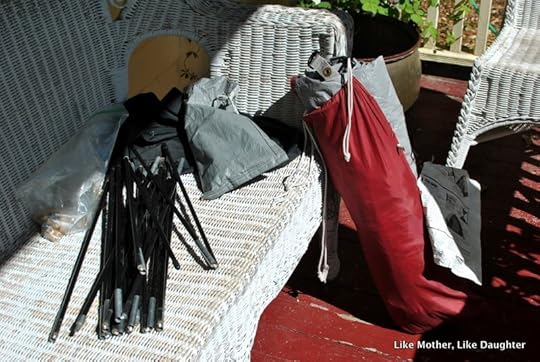
In fairness, my battery died after this.
I was going to muse on the fun of packing up camping gear as you head off to your junior year at college, and maybe, just maybe, I would have taken a picture of Bridget, but maybe not, because I’m not sentimental like that; I tend to be focused on all the things I have to do (because I have postponed them, because I can’t bear to think of summer being over).
But probably not; viz., I didn’t even take a phone picture. Maybe she’ll post one on her IG. I already miss her, so I hope so!





(These little things, above, are Cape gooseberries, also known as ground cherries. They are quite delightful and grow really easily.)






I keep reading others’ updates about getting the kids back or off for the first time to college, and about starting them off at kindergarten, and about getting back to homeschooling.
Every fiber of my being resists all this.
I can’t explain it. To me, the onset of fall is a reminder of all I’ve left undone in the soaking-up-sunshine department… and I’m not good at planning ahead.
I will remind you (because I’m sure I’ve written about it before) that we never started our schooling until well after Labor Day, if we could help it (and sometimes we couldn’t, due to the unreasonableness of the powers that be, and we always had someone subject to those powers). Sometimes our home school didn’t start until near October.
I always thought that in the depths of February we wouldn’t mind having made that choice.
I happened on a book review (this one, about Jacob Neusner, “the most published man in human history,” “arguably one of the most influential voices in American Jewish intellectual life in the past half-century”) the other day, the umpteenth reminder that the most interesting and productive people in the world were misfits as children.
It made me want to come here and tell you this about educating your children, whether in school or at home: How would you feel as the mother or father of a third grader whose teacher said about him, “He prefers not to do as the others are doing, which causes many difficulties”?
But then, how would you feel as the mother or father of the adult (that grown child!) who received the Medal of Pope Benedict XVI, or who lovingly and intelligently raised a family of her own, or who could run a company, or who could engineer something needed? … for example?
I guess I’m trying to say that there is no “one thing you need to know” about the education of the child. There’s no denying that — even if you delegate part or most of the formal education to others! — it takes energy and trustfulness. Not just energy; not just trustfulness.
The young child needs to learn certain things, but somehow, the world itself is set up for him to learn those things, if we mostly stand out of the way, only stepping forward to offer a few key things at opportune times.
The older child needs, among many other things, to read a mountain of books; this necessitates a corresponding amount of reading on our part — even of books we’ve read and studied in the past. Being the mother or father of an older child learning at home is an exercise in changing the whole way we interact with the world, because now we must wrestle with Plutarch and Dickens and Faraday… and very likely a baby or two as well! That is, the mother of such a child finds that it’s real work to homeschool.
But we aren’t programming a machine; we’re guiding a soul, a unique person who will learn if we just give him room. Not only learn, but head off in directions we hardly imagined — that’s when we find out that we can render even shortcomings on our part into freedom for this child who, it must be said, is not precisely a child of ours.
So this is just a pep talk on the subject of any anxiety you might be feeling as you raise your children (or any false sense of security you might have when you put your confidence in a system or process of education). In one sense, there’s no mystery: children have always grown up and learned things, if given half a chance. Of course, that half of a chance consists very much in being left alone to think, and in reading, and in having smart people to talk to and who love them.
In another sense, the mystery is real, and so no one can “fix” it with their one easy solution or their complex method. Parents really are in the closest contact with the one thing no one knows much about, despite having been one: a developing human person. Don’t be surprised if this seems difficult, but don’t be afraid to relax, either, as it seems to be just the way it is supposed to be!
Sometimes, only after actually raising children do you realize what went into it, I guess I’m trying to say.
And that’s when you see that it’s the goal that should determine your choices. That review that got me started here really reminded me that the goal can’t be “to do what the others are doing” or even “to perform well at this level.” It really has to be that we offer the child the environment and the necessary support (that is, love) to “become what he is” in Saint John Paul’s phrase. Sometimes even our failures can be useful, that means — which is surely good news!
Today, as I read the reading in the Office, from Paul’s first letter to the Corinthians, I thought of how much confidence we have to have in something outside of ourselves when we are faced with such a long-term task as the education of our children. I thought about how we have to be fine with doing our best in God’s sight and not worrying about how it appears to man; far less about how we feel about this (and really any!) project:
People must think of us as Christ’s servants, stewards entrusted with the mysteries of God. What is expected of stewards is that each one should be found worthy of his trust. Not that it makes the slightest difference to me whether you, or indeed any human tribunal, find me worthy or not. I will not even pass judgement on myself. True, my conscience does not reproach me at all, but that does not prove that I am acquitted: the Lord alone is my judge. There must be no passing of premature judgement. Leave that until the Lord comes; he will light up all that is hidden in the dark and reveal the secret intentions of men’s hearts. Then will be the time for each one to have whatever praise he deserves, from God. (1 Corinthians 4:1-16.)
I have lots of education and homeschooling thoughts.
You can scroll through the “education” category; you can read about teaching a child to read (start at the beginning), to write (the previous posts in that category are linked at the end of this one), to observe.
There are thoughts on teaching history here and here.
I’ve written in general about homeschooling and have lots of reading suggestions for you in those posts. Don’t miss this one with answers from Auntie Therese.
Don’t forget the Library Project!
The post As a new school year begins, some thoughts. appeared first on Like Mother Like Daughter.
August 17, 2016
Almond bathroom fixtures: a make-do bathroom makeover!
{At the end of this post you will find paint colors to update your almond fixtures, and notes about sources. The Amazon links are affiliate links.}

I have come to that point where either I show you some pictures of my bathroom makeover in its not-quite-complete form or I give up altogether, because in real life, the “done” things very quickly get to be decidedly worn out, even as you are trying to finish up the details.
And that would not be good, would it, for me to wait so long that the new things got old. So that’s what I’m doing — showing you the way it is in real life, namely, not quite done (or ever likely to be!).
I have one million things to tell you.
We redid two bathrooms at once, simply because they are right next to each other and it seemed to make sense in terms of economy of scale. I’m not sure if that turns out to be correct. It certainly makes sense in terms of one’s willingness to return to chaos after one stage has been dealt with. It also makes sense when the second one is completely unusable, as opposed to the first which is just crumbling.
Here is a diagram/plan of our second floor. Those of you who know me well, know my little attempts to give you an overview of things… which may or may not be helpful.

What this is conveying to you, in my own wacky way, is that in an old house, choices have to be made, usually according to things known as “stacks” — places where plumbing gets put in and it’s just simpler to go up with it to the next floor than to, you know, actually put it where it’s needed.
Thus, yes, I go a far piece to get to the bathroom. (The Chief also does, but, you know.) And those bathrooms are next to each other. Because, plumbing.
I will show you the other one at some point. We are putting shelving up and then I hope to!
Here are some befores. Please remember that befores are usually taken at the very last minute, after the leaks have gotten bad and pretty much when the demo has begun and suddenly you’re like, “Let me stop the hating for a minute, just for the sake of the blog.” So don’t judge me too harshly; it wasn’t quiiiittte this bad. Well, not till the very end.
BEFORE:

The leaks had sprung, and that’s what the towels are all about. In my dreams, I would have had an upscale construction company come in here and gut everything, and I would have put in black and white tile and white porcelain fixtures. There would be a freestanding tub with a shower; I don’t see what’s wrong with that! I like it, and it’s old-fashioned and timeless. Plus, way easier to bathe a baby in, versus a dumb jacuzzi and too-small shower.
However, that was not to be.
It’s just too expensive to rip out these built ins. Let this be a warning to you! Try not to build things in. That tub — not going anywhere. Likewise the vanity. It would just cost so much to replace it with its built-in sinks.
That meant that we had to work with the almond. I know. But because of that, I’m here to tell you the best way to do that in terms of decorating!
BEFORE:

Somewhere along the way, when I was still nursing that black-and-white dream of mine, we replaced the old almond (terrible and malfunctioning) toilet with this nice white one.
My reasoning — what would be the point of putting in new almond one if we were on track to gut this bathroom and make it all NOT ALMOND?
Yeah. After crunching the numbers (and recovering consciousness, and paying the tuition bill), we did end up getting one to match, and this beautiful white number is in the new laundry room.
Now, I want you further to note the golden oak trim. Baseboards, windows (sorry, no befores of that), and the radiator cover. I spent a lot of time trying to figure out how to incorporate almond fixtures and golden oak trim, and then I came to my senses.
The trim was getting painted.
AFTER:


I took the radiator cover down to the garage and spray-painted it. It’s at times like this that spray-paint earns its keep. Painting all that metal screen with a brush would have been a nightmare of drips and surfaces!
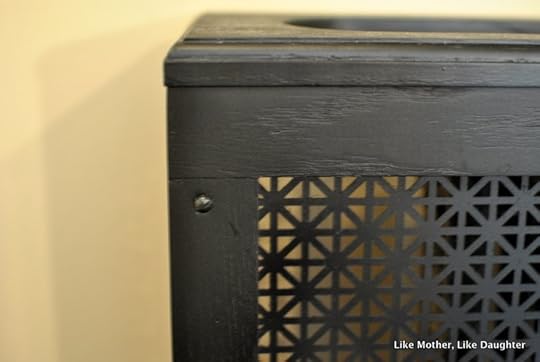
I also spray-painted the radiator underneath. It had been white and the white showed through the mesh and contrasted with the black. However, I would not do that again — spray painting inside is not a good idea!
We got a bigger shower. The space above the new wall is open on the theory that air circulation is a good thing.

The trick with the almond is to go a bit darker on the walls, and a white-leaning-towards-gray-taupe (taupe is beige with black in it, or brown/black with white in it, however you want to look at it) for the trim.
Black accents lift everything up out of the 70s-90s. I painted the light fixtures black and got new glasses for the sconces.

I do really love the flooring. It’s vinyl plank (not laminate sheets). It’s completely waterproof and floats on the subfloor — in this case, partial tile and partial plywood. Just covers it all up and provides a warm, easy to clean surface. I love the color of it.
I call it “Escape from Golden Oak.”


The paint and a bunch of the black we had already decided on in the last go-round (the real before featured blue wallpaper, which, who puts wallpaper in a bathroom I ask you, and blue is not a good way to uplift almond). The vanity had been golden oak; I hadn’t thought to take a before picture (there is a similar one on this blog), but I was very pleased with how the hardware went from blah to fab, just with the color change.




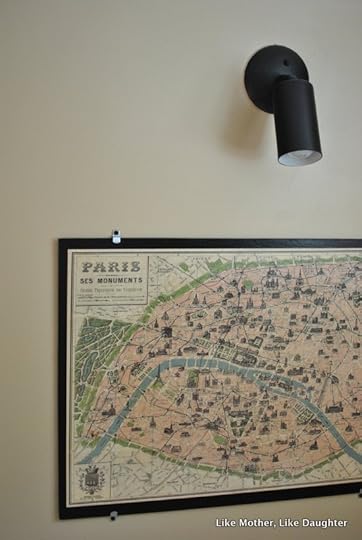


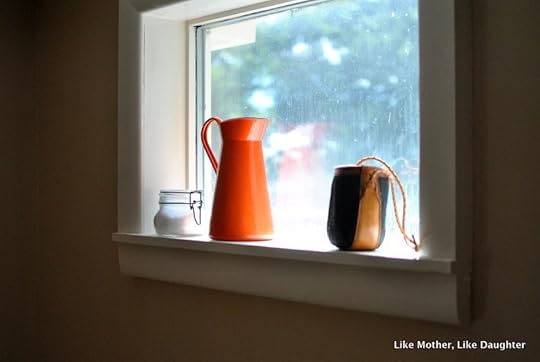

We did update the faucets. Surely you can see why…
BEFORE:


AFTER:

I will say that the surround of the tub and the countertop and backsplashes are all Corian. I like that surface. I would have liked it not to be almond, but oh well.

One little note you might not think of: The nice-looking black and chrome toothbrush holder from Target (as seen in the before pic just above)?
No good.
No matter how much you rinse the toothbrushes, the dried residue is white! Making your holder look gross. I spray painted mine white.

There are nice touches in old houses…
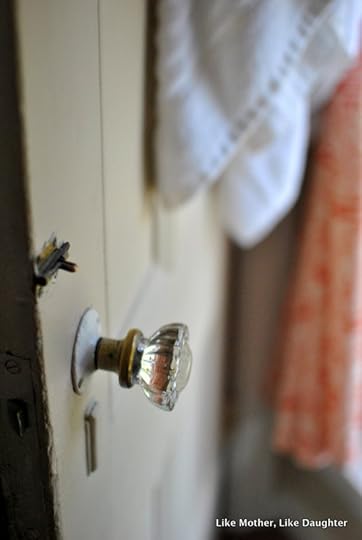
Before:

After:

Things I would do at some point:
Touch up the black of the vanity and the frames of the mirrors
Spray paint the towel ring between the two mirrors black
Replace the window over the tub so that it opens (which, among other things, would allow for it to be cleaned on the outside; it’s over the roof of the garage, so a cleaning isn’t happening otherwise!)
Replace or paint the faucet of the tub
Line the curtain to make it look a bit more substantial — this requires coming across a good length of muslin at some point
Paint and sources:
Walls: Olympic, Sienna Sand (which may be the Benjamin Moore name which we originally used, but they can make it at Lowe’s)
Trim: Valspar Cliveden Mist (first we primed the oak well)
The black is just some random black in the case of the vanity (I don’t remember, but just don’t get a blue-black) or black spray paint
Ceiling paint: Take a tip from me and use glossy paint for your bathroom ceilings, preferably one that is mold-resistant — this was a huge upgrade from the regular ceiling paint that had been on there before
Flooring: Shaw’s Matrix Regency Vinyl Plank Flooring in Gunstock, from Lowe’s (I bought this after buying a similar product from Home Depot; I was actually hoping for a lighter color (which I think doesn’t show as much dirt). I was checking out with enough flooring for both bathrooms and caught sight of a sample laid out. My, it was ugly! So I turned right around and returned it all! After much texting of photos to Rosie and a considerable amount of agonizing over the fact that some colors are in stock and some are decidedly not and anyway how are you supposed to tell, I found this one at Lowe’s. I love it.)
Toilet: Gerber
Shower: Got it from the plumbing supply store — it is 5′ wide and has a built-in seat! The door is from Lowe’s and is suspended from the top, making it easier to clean
Faucets: Ufaucet from Amazon. These are very nice and the pop-up drain is metal, not plastic, and the price was right
Towel racks/hooks: Spray painted regular hooks black; Phil made the peg board; carved wooden hook from Marshall’s
Paris map: Available at art stores that sell wrapping paper, for under $4, or here on Amazon for more. I decoupaged it onto a spray-painted piece of particleboard that we had, so the whole thing cost me $5
Curtain fabric: JoAnn’s
Other art: Thrifted, or decoupaged greeting cards — the “abstract art” is actually a picture of a Gee’s Bend quilt, and however much a source of contention it is in my family, I love it for the sweet thriftiness it represents
Shout-out to Bridget who helped me choose the fabric and who did a lot of painting!
The post Almond bathroom fixtures: a make-do bathroom makeover! appeared first on Like Mother Like Daughter.
August 13, 2016
{bits & pieces} and a matchbox makeover
The weekly “little of this, little of that” feature here at Like Mother, Like Daughter!
Back when I was overhauling our collection of art supplies, I found a more streamline-able spot for the crayons that originally came in this box. I set it aside to think about how it could be re-purposed. I mean, just look at this! Packaging that was not meant to be thrown away:

Brilliant — it is the perfect size for matches! For a little oratory!

Some washing and drying and maybe a little sanding (honestly don’t remember; this was a while ago); a coat of gold acrylic paint (which turned out to be more like a champagne-sparkly veneer, not really paint)…

Some cobalt inside just to keep things exciting…


An abrasive strip attached…

And voila. 
We’re currently a bit “between candles” in our little oratory, so the matchbox isn’t getting a lot of use at present… but we’ll work on that. The one candle we have going right now is to the right, outside of the frame of this shot.
Now that I’m looking at it again, I think it’s asking for some cobalt designs on the sides. Someday.
Shout-out to the people who sell their goods in well-made little wooden boxes!
On to this week’s links!
Practical announcement: You or someone you know may be interested in a new online degree program from my Alma Mater: a Master of Catechesis. 6 of the 30 required credits are internship credits, which can be earned at one’s current place of employment (if applicable) or, if the student isn’t already in such a setting, the University will help to place him in one. It could be completed in one year by a full-time student. There are some scholarships available.
For when you’re up for some heavier reading:
The Meaning of a Martyrdom. Ross Douthat argues that Father Hamel did indeed die as a martyr.
Political philosopher Pierre Manent on the future in France after the killing of Father Hamel: Does French Culture have a Future?
Satan Fuels Islamist Violence Against Christians — an execllent and balanced inquiry into the affair and into what Christianity thinks of Islam.
Some commentary on the latest stats on the dangerously low birth rates in the U.S.
In this article from Crisis, the author runs through some examples from Tolkien to consider how we might live in the present age: Tolkien Alternatives to the “Benedict Option.”
Miscellany:
If you’re in the mood for some exciting and stunning (and time-travel-y) photos of a seemingly very intense festival (about which we know nothing), look no further than this collection: Meet the Samurai of Fukushima.
The BeauEr: a trailer that expands with the touch of a button. For those dreaming of the road…
If you love to read about Harper Lee, you might be interested in this article by Ari Schulman (a friend) about a literary agent his own grandfather shared in common with Lee: The Man Who Helped Make Harper Lee.
Some more for Simone Fever: The Fine Line — the NYTimes’ slide show analysis of her performance. I appreciate this breakdown because I have a hard time processing her crazy skills! And let’s not forget that Simone Biles is an adoptive child, who could have been written off as “unwanted,” but for her grandparents who stepped up to be her parents.
You know I like to throw in a token, Be Wary of Screen Technology piece: How Screen Addiction is Damaging Kids’ Brains. “I’ve worked with hundreds of heroin addicts and crystal meth addicts, and what I can say is that it’s easier to treat a heroin addict than a true screen addict…”
From the Archive:
Less Exasperated; or, Two Rules that Might Help
DIY Roman Shades (with Auntie Leila’s Tweak). This is still one of our most sought-after posts!
~We’d like to be clear that, when we direct you to a site via one of our links, we’re not necessarily endorsing the whole site, but rather just referring you to the individual post in question (unless we state otherwise).~
Follow us on Twitter.
Like us on Facebook.
Auntie Leila’s Pinterest.
Rosie’s Pinterest.
Sukie’s Pinterest.
Deirdre’s Pinterest.
Habou’s Pinterest.
Bridget’s Pinterest.
Habou’s Blog: Corner Art Studio.
Auntie Leila’s Ravelry.
Auntie Leila’s Instagram.
Rosie’s Instagram.
Sukie’s Instagram.
Bridget’s Instagram.
Save
Save
The post {bits & pieces} and a matchbox makeover appeared first on Like Mother Like Daughter.
August 12, 2016
Music and Liturgy ~ The Spirit of the Liturgy, A Book Club

{Book Club: The Spirit of the Liturgy}
I hope you will read along in this book club (or just read my posts, that’s okay): Joseph Ratzinger’s The Spirit of the Liturgy.
(When you buy something via our Amazon affiliate link, a little cash rolls our way… just a little. Thanks!)
I’ll post on Fridays, although for this longer book, perhaps not every Friday. I’ll give you your homework, I’ll talk about what we read, we’ll discuss in the comments. Even if you read later, the comments will still be open.
Previously:
Introduction to the reading: Joseph Ratzinger’s The Spirit of the Liturgy: A Book Club for Easter and Beyond
Nature or history in worship? Or both?
The Relationship of the Liturgy to Time and Space: preliminary questions
The Reservation of the Blessed Sacrament
Homework: Read Chapter One of Part IV: Rite
Chapter Two, Part III: Music and Liturgy
If you are under the impression that music is a tidy little subject with a take-it-or-leave-it sort of character, like flowers by the altar, I’m here to tell you that such is not the case.
I’ve said before, I’m impressed that Joseph Ratzinger crammed many, many thoughts about music in general and sacred music in particular into one chapter. It’s kind of breathless, isn’t it?
Everything he writes about music speaks to two main points, one of which is not quite spelled out; that would be the question of whether music exists — is it objective? Does it correspond to something outside of us? Is it real? Does it arise solely from creativity as we think of it today — a sort of almost random expression of what we happen to be feeling?
We can trace this question to an emphasis in recent Church documents on the “gathering” aspect of music in worship (Mt 18:20). How easy it has become for some to move from “gather in my Name” to “become a sort of institution that chooses its own way.”
The other question makes up the heart of the chapter: What is music in worship and is it integral?
I think there is that kind of curmudgeonly pious person (very much in the Catholic Church — don’t know if the same type is found in Protestant circles) whose take on music is “I much prefer no music! Just leave me alone to pray.”
It’s an understandable reaction to the liturgical music landscape that Joseph P. Swain in his book, Sacred Treasure, calls “a desert of mediocrity.” But is it the right reaction? Is music dispensable?
Well.
To answer the first question, I would suggest that you read David Clayton’s The Way of Beauty, an excellent primer on the mathematics of music and how said mathematics, well known to the ancients, are actually the bridge between the world of abstract ideas and the world of created beauty. In fact, one could argue (but would be foolish to attempt to do so in a blog post) that without music we cannot escape preference (mere taste and its subsequent degeneration into meaninglessness). With music, we can confidently create and recognize beauty in the world and in history, including the present time.
Ratzinger begins at a different point — more in the midst of the second question, which relates to music in liturgy.
In the first few pages of the chapter, he argues that to sing is precisely to transcend the spoken word — and to escape death, which is the goal of worship: union with God beyond this earth.
I love this main point of his, the key to all he thinks about music:
Yes, singing, the surpassing of ordinary speech, is a “pneumatic” event… a gift of the Spirit… It is above all in Church music that the “sober inebriation” of faith takes place — an inebriation surpassing all the possibilities of mere rationality. (P. 140)
Again, he speaks of Logos — of that transcendent Word, of meaning, in which we are united with God, who in turn has a nuptial (wedding) union with His Church. (P. 142)
All religions use music. But we have to understand history well enough to know that they precisely use it — for a purpose, which is to effect a release from human nature. And today there is another phenomenon, which is the corruption of popular music.
On the one hand… pop music… is aimed at the phenomenon of the masses, is industrially produced, and ultimately has to be described as a cult of the banal… on the other hand… at rock festivals it assumes a cultic character, a form of worship, in fact, in opposition to Christian worship… People are, so to speak, released from themselves by the experience… However, in the ecstasy of having all their defenses torn down, the participants sink, as it were, beneath the elemental force of the universe. The music of the Holy Spirit’s sober inebriation seems to have little chance when self has become a prison, the mind is a shackle, and breaking out from both appears as a true promise of redemption that can be tasted at least for a few moments. (P. 148)
You might say that in exalting (but also manipulating) popular music (which of course, if it is truly from the people, has its authentic place) man ends by giving into animal nature as a form of release.
The point of sacred music, however, is to bring human nature into the divine realm as a fulfillment.
Here Ratzinger offers a brilliant device for understanding the divide, the immense gulf, between the conception of music as an expression of something above man and the view of music as an tool of the Will, which the modern era has buried within man and ultimately, found as not separable from him. This view devolves into feelings and ultimately, degradation.
And that device is what he calls “the Apollonian/Dionysian alternative” which “runs through the whole history of religion and confronts us again today. Not every kind of music can have a place in Christian worship. It has its standards, and that standard is the Logos.” (P. 151)
Earlier on page 150 he explains the analogy:
Plato ascribes, in line with mythology, [music] to Apollo, the god of light and reason. This is the music that draws senses into spirit and so brings man to wholeness. It does not abolish the senses, but inserts them into the unity of this creature that is man… uniting them with the spirit. Thus this kind of music is an expression of man’s special place in the general structure of being.
But then there is the music… that we might describe, in terms of [liturgical] history, as “Dionysian”. It drags man into the intoxication of the senses, crushes rationality, and subjects the spirit to the senses.
When we think of the divine realm, we must understand that the music is already going on!
Ratzinger points us to Scripture: “the liturgy is echoing… the vision of God in Isaiah chapter 6… the prophet sees the throne of God, protected by the seraphim, who call to one another: “Holy, holy, holy is the Lord of hosts… In the celebration of Holy Mass, we insert ourselves into this liturgy… All our singing is a singing and praying with the great liturgy that spans the whole of creation.” (P. 151-152)
It is here on page 152 that Ratzinger touches upon the importance of number, of the physics of the planets, of the order of the universe.
The music made by man must… be taken from the inner music and order of the universe, be inserted into the “fraternal song” of the “fraternity of the spheres”. The beauty of music depends on its conformity to the rhythmic and harmonic laws of the universe.
So, the problem we have today is that those in charge of our music are also attempting to achieve in us this sense of release/ecstasy/feeling. They are utterly committed to the Dionysian form of music. At best (from our point of view), their “art” is banal, merely serving to break up silences. At worst, it renders Guardini’s “spiritual silence” of the liturgy impossible.
I could go on.
Instead, let me give a couple of examples, one bad and two good.
In the aforementioned Sacred Treasure (a new book about sacred music that I am currently reading), Joseph P. Swain examines the “impoverished,” “relentlessly regular,” “nursery singsong” “Celtic Alleluia” which perhaps many of you are routinely subjected to have heard.
This “Celtic Alleluia” requires of you that you have a certain disposition when you hear or sing it — it assumes a cheerfulness that you may or may not be experiencing — and it also enforces a response.
It wants you to march (due to its “swinging triples”). It is not universal in its character — on the contrary, it’s incredibly specific to a time and a place (and I’m not sure that the place is Celtic at all). It imposes its will on you. You might initially respond to it positively. Please listen to it a few times and begin imagining how you would feel if you were at Mass having just had a miscarriage, or had had fight with your boss, or had just remembered something you did as a teenager that you are ashamed of, or had invited a friend from Ghana or Iran or Singapore.
Many people find chant off-putting. But bear with me here.
In contrast to that Alleluia above, plainchant has no defined meter. Its rhythm is at the service of its words, but is also united to them. It is mystical and is only used in liturgical applications — thus, it fits the “otherness” of the liturgy, the way the gold of the chalice fits, and the silk of the vestments.
For instance, you can’t imagine it being used in a Broadway play (my own personal test of whether music is sacred!), except precisely to evoke the sacred.
It doesn’t demand anything in particular of you, and thus it is able to be universal — a grieving mother or a happy child or a thoughtful old man can equally enter into its call.
Here is the most common simple tone (IV) Gregorian alleluia that you might be familiar with:
(Ironically, I couldn’t find any other example on You Tube other than this one that goes with a missalette, which of course is otherwise almost exclusively comprising what I’d call “bad” liturgical music! But this chant is nicely done. Note her relaxed tone.)
And here is an Alleluia from the Mass of St. Philip Neri, composed by our dear friend Paul Jernberg. It’s more Byzantine in its chant style, and it is also polyphonic. But it retains the characteristics of chant in that its meter is free and it is sung in a relaxed, un-Dionysian manner. (This is at my church and you will see Bridget there in front on the left with the scarf! I was there but sat this one out as I had a cough.)
Maybe listen a few times and imagine yourself in those circumstances I threw out above, for each of these examples.
Clarifying, isn’t it?
I leave you with a few quotes:
“Is Liturgy primarily latreutic, concerned with the adoration of God, or is it first and foremost didactic or edificatory, the conscious vehicle of instruction of individuals and the upbuilding o f a community? – Aidan Nichols, OP
“Liturgy can only be liturgy to the extent that it is beyond the manipulation of those who celebrate it.” – Joseph Ratzinger
“Humble submission to what goes before us releases authentic freedom and leads us to the true summit of our vocation as human beings.” – Joseph Ratzinger, p. 156.
{Palestrina’s Sicut Cervus, a polyphonic setting of Psalm 42, one of the most sublime works of sacred music of all time.}
Questions? Comments? I’d love to hear from you!
(Emphases added in quotes are mine.)
Click here to see our previous discussion of Romano Guardini’s The Spirit of the Liturgy, which you can read free, online. You can also purchase it here, although be warned, this edition does not have the footnotes, which stinks .
.
The post Music and Liturgy ~ The Spirit of the Liturgy, A Book Club appeared first on Like Mother Like Daughter.
July 30, 2016
{bits & pieces} ~ patching a hole!
The weekly “little of this, little of that” feature here at Like Mother, Like Daughter
Back when I had first started re-covering my deck furniture, I told the sad tale about how I went through all that work (mostly the mental work of committing to doing it!), only to find that directly afterwards, some animal chewed two holes in my new covers!
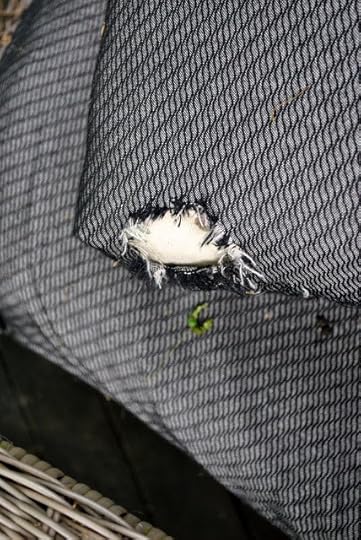
So not fair!!
You couldn’t chew old ugly coverings, you bad varmint!?! You had to chew the new ones?! UGH.
Of course I had quickly tossed the scraps from the project, because “you shouldn’t keep stuff around ‘just in case it comes in handy'” and other lies we tell ourselves.
For five years I made sure the sides with the holes didn’t show, which is a pain! Because you need to flip cushions! Double UGH.
Well, flash (and I use the word flash in the sense of “slowly drag yourself”) forward to 2016 and — ta da! — I fixed it! Because, in getting that last settee done (you can see the befores and afters by clicking that link), I once again had scraps! (This fixing of the holes, by the way, was a huge incentive to get the same fabric rather than making do with something that merely coordinated.)
I thought you might like to see how to make the least obtrusive patch you can.
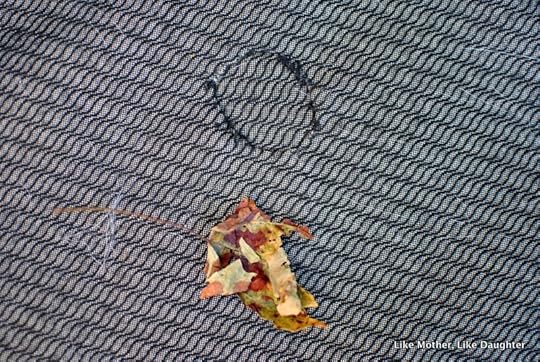
The trick is to sew the patch underneath the hole, not on top. Just roll the edges of the hole under and, using the smallest, most hidden stitching you are capable of, sew the edges onto the piece of fabric you have cut to be just slightly larger than the hole (leaving, say, 1/4 inch all the way around for allowance).
I think I did an even better job on this one, as I took care not to let the design rotate as I was sewing it:
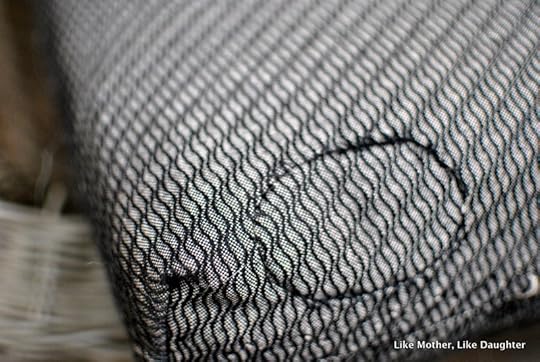
The fact that the pattern here is not solid really helps fool the eye, I think. I’m not ashamed to flip the cushions now.
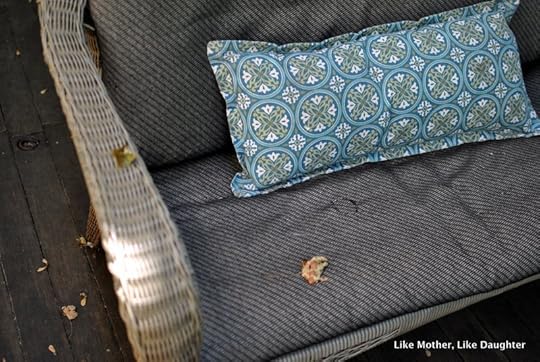
Onto our links:
Here is a rather overwrought article about two fascinating (but hardly epistemologically uncertain) burglaries.
I myself have a beautiful, gossamer silk blouse that was made from a parachute from World War II — it was my aunt’s. I don’t fit into it anymore, but maybe one of the girls should make me dig it out. This article is about a dress made of silk that was used as the substrate for printing maps of enemy territory.
All of us, as parents, have to be concerned with the state of education. We have a sneaking suspicion that the university is not a wholesome place, but we are not exactly sure why. This important sketch of “The Most Dangerous Socialist in History” will help clear things up. We were right not to trust our institutions, which have been the object of a “long march”.
If you are friends with me on Facebook, you probably already saw this post on Your Rights During a Miscarriage, but I think it’s important enough to post here as well. It’s so hard to know what to do — and what you can do — when you are experiencing a miscarriage. Good to have read some information beforehand. I wonder if there is something similar for ectopic pregnancy? Let me know in the comments.
I do really enjoy reading David Warren, although he’s not super cheerful. This time, Why Our Problems are Insoluble.
A friend mentioned this little series (I’m linking to the archive because he doesn’t link the posts up to each other) on Christopher Alexander’s A Pattern Language. That led me to this little post of John Cuddeback’s on the Secret of the Marriage Bed. Really, it’s only two paragraphs, other than the quote from Homer. The second of the two is gold. Pure gold: the secret of the marriage bed.
This secret is why my post giving you a list of books on marriage prep has only five or six books on it. Guard the secret, teach your children to guard the secret, for it is the secret of life.
I thought this long article gives deep insight into “the daily work of a hospice nurse, who treats the physical, psychological, and spiritual needs of people at the most vulnerable point of their lives.” I never expected to read the Catholic prayer for the dying in the New Yorker.
Today is the feast of St. Peter Chrysologus (“the man of golden speech”).
From the archives:
In the middle of the season, the reminder to make your menus can help stave off food prep paralysis.
A really good grilled eggplant recipe: Eggplant Obsession.
One of those times where I talk about censorship and dish towels, in all violation of the known rules of keeping to one topic per post.
~We’d like to be clear that, when we direct you to a site via one of our links, we’re not necessarily endorsing the whole site, but rather just referring you to the individual post in question (unless we state otherwise).~
Follow us on Twitter.
Like us on Facebook.
Auntie Leila’s Pinterest.
Rosie’s Pinterest.
Sukie’s Pinterest.
Deirdre’s Pinterest.
Habou’s Pinterest.
Bridget’s Pinterest.
Habou’s Blog: Corner Art Studio.
Auntie Leila’s Ravelry.
Auntie Leila’s Instagram.
Rosie’s Instagram.
Sukie’s Instagram.
Bridget’s Instagram.
The post {bits & pieces} ~ patching a hole! appeared first on Like Mother Like Daughter.
July 29, 2016
What is Sacred Art? ~ The Spirit of the Liturgy, A Book Club

{Book Club: The Spirit of the Liturgy}
I hope you will read along in this book club (or just read my posts, that’s okay): Joseph Ratzinger’s The Spirit of the Liturgy.
(When you buy something via our Amazon affiliate link, a little cash rolls our way… just a little. Thanks!)
I’ll post on Fridays, although for this longer book, perhaps not every Friday. I’ll give you your homework, I’ll talk about what we read, we’ll discuss in the comments. Even if you read later, the comments will still be open.
Previously:
Introduction to the reading: Joseph Ratzinger’s The Spirit of the Liturgy: A Book Club for Easter and Beyond
Nature or history in worship? Or both?
The Relationship of the Liturgy to Time and Space: preliminary questions
The Reservation of the Blessed Sacrament
Homework: Read Chapter Two of Part III.
Chapter One, Part III: The Question of Images
This chapter and the one following are about art and the liturgy.
It’s hard to believe that Joseph Ratzinger would expect to deal with images in the liturgy in one chapter, and pretty much get away with it. Of course, that leaves us to try to figure out what he’s saying, in the space of a blog post! Yet, there’s no denying that we are in need of some principles, because the state of art and music in the Church today is deplorable, no way around it, largely because we’ve conceded the main question, which is, “What is art?”
Is art — is beauty — essential? That is, does it go to the essence of a thing? Or is it, how shall we put it, optional, or an add-on? Is it superficial, like a veneer, covering the real thing, maybe hiding it? Or a sort of trick, a way to snare those who aren’t paying attention to abstractions? Is it somewhat unreal, in contrast to spirituality, which is real?
What is art? What is sacred art?
That is, if we decide that the church building should have images, does that mean that any image will do? How would we decide?
And if art, specifically in terms of image, is essential, what do we make of the Commandment against graven images?
The ancients, with a terseness that hints at the elusiveness of beauty, called it “the radiance of truth.” I think it will be helpful to keep this definition in mind as we talk about art — specifically, what constitutes sacred art.
Well, let’s dive in!
Ratzinger, to begin, demonstrates that the Christian acceptance of image is in continuity with Jewish tradition and thus, with the First Commandment, to make no graven image. The images discovered in archaeological finds demonstrate an important point which Ratzinger will return to again and again, and which forms the center of his liturgical understanding: images used in the worship of the One God in the synagogue (as opposed to images worshiped as God, which is what’s forbidden) are not like pictures in a history book, meant to illustrate something in the past. They are, rather, “a narrative (haggadah), which, while calling something to mind, makes it present.” (P. 117)
This being made present reaches its fullness in the sacramental action of the Church, with “the expression of a new experience of time, in which past, present, and future make contact, because they have been inserted into the presence of the risen Lord.” (P. 117)
As we keep the definition of art, of beauty (“the radiance of truth”) in mind, we appreciate the importance of Ratzinger’s insistence that images “have the character of mysteries, going far beyond the didactic [instructive] function of telling the stories of the Bible.” (P. 118)
My friends, we are almost — almost — beyond understanding this point, in the rationalist age we live in. For us, art has two purposes: to make us feel something and to instruct us in something. But as to giving us a window on a truth — in fact, radiating the truth — we are very nearly impervious!
Thus, those few of us on this journey of “The Spirit of the Liturgy” must pay careful attention to the arguments of these two chapters in this section. We must approach them as if they are written in a different language, not taking any words for granted.
We think we know what he means by image — and we do not! This, alas, is the legacy of our epoch, the modernist epoch in which we live, sadly divorced from the hope of encountering truth, floundering about in the swamps of the Will. Do you remember the discussion from Guardini’s last chapter — about the primacy of the Logos over the Ethos? The gist of what he was saying is that if we rely on Will — on using force, energy, even persuasion and argumentation — to effect change or understanding or enhancement of spiritual unity, we make a mistake.
Now we begin to see why the earliest Christians weren’t interested in making a portrait of Christ in the sense that we would probably expect them to. They rather wanted to radiate the truth, the meaning, the Logos, the Good Shepherd who enters into history to rescue the sheep, by means of the image. (P. 118)
We will talk much more about this in the next chapter, on music, but for now, a certain awareness that we have lost this connection of beauty to truth will take us far. Sometimes, knowing what you don’t know helps!
At the same time, the emphasis on the sacramentality of the icon (which means “sacred image” in Greek, but also has a more particular meaning for us) led to difficulties.
The Greek longing for the vision of the Eternal seemed to be fulfilled [in the “icon not made by human hands, the “true face of Christ”]. Thus the icon inevitably assumed in its form the status of a sacrament. It was regarded as bestowing a communion no less than that of the Eucharist. People began to think that there was virtually a kind of real presence of the Person imaged in the image.
This led to the reaction of iconoclasm — both the theoretical opposition to images and also the physical destruction of not only images but all manner of liturgical accoutrements. As Ratzinger points out, this movement had a political side; also, it was not without irony, in that its major proponents were some of the most sumptuously indulgent, worldly men of the day.
The pages in this chapter outlining the history of images in worship are worth reading: “In the course of this struggle the true theology of icons matured and bequeathed us a message that has a profound relevance to us today in the iconographic crisis of the West” — that is, our present-day struggle to recover beauty in worship.
We in the modern age are living through our own period of iconoclasm. We are caught between the need for beauty in life and worship, and a profound mistrust of the material world. The answer, as before, can only be understood if we finally realize that the question concerns the Incarnation; that is, the consecration of the created world through man’s mediation. “The crisis of art for its part is a symptom of the crisis of man’s very existence.” (P. 130)
In the interim between these early disputes and ours, a new difficulty has arisen, the difficulty of finding meaning itself outside of the mind of man — outside of what becomes mere preference.
The immense growth in man’s mastery of the material world has left him blind to the equations of life’s meaning that transcend the material world. We might almost call it a blindness of the spirit… Positivism [the ascendency of Will, of Ethos] formulated in the name of scientific seriousness, narrows the horizon to what is verifiable, to what can be proved by experiment; it renders the world opaque [vs. the way of beauty, which bestows clarity]. Ture, it still contains mathematics, but the logos that is the presupposition of this mathematics and its applicability is no longer evident. Thus our world of images no longer surpasses the bounds of sense and appearance, and the flood of images that surrounds us really means the end of the image. .. art itself… becomes literally object-less…. no longer perceives the… Creator Spirit…. it manages to produce only what is arbitrary and vacuous, bringing home to man the absurdity of his role as creator. (P. 130-131)
In short, image as the radiance of logos has been reduced to act. But where does that leave beauty?
Let’s finish as Ratzinger does, by summarizing his principles, principles that speak particularly to the question of what kind of images can be thought of as sacred:
One: Resolve to meditate on the Incarnation, for this is the key. God was made visible! Beauty entered the world — Jesus Christ is the radiance of the Truth. “Iconoclasm is not a Christian option.”
Two: Beauty and holiness go together. Holiness is the radiance of goodness. Beauty is the radiance of truth. We learn holiness by means of salvation history, which is the proper subject of sacred art — and know that history here means the history of earth and heaven, the seven days and the Eighth Day, the day that takes us beyond history to the heavenly realm. And thus, beauty must have as its subject the saints! Without the saints, how will we know holiness? For they are those who have fulfilled that dictum that God became man that man might become divine.
Three: “Every image of Christ must contain these three essential aspects of the mystery of Christ” — that is, Christ crucified, risen, and come again. These three presuppose the Incarnation. What is Ratzinger saying here? That for an image to be considered sacred, it must not be a representation only of one aspect of His saving action.
This point in particular can help us discern whether an image is holy or not, suitable for worship or not. “An image of the Crucifixion no longer transparent to Easter would be just as deficient as an Easter image forgetful of the wounds and the suffering of the present moment…. the image of Christ is always an icon of the Eucharist… points to the sacramental presence [not historical only] of the Easter mystery.”

To understand this point, I’d say that it would be a good idea to study sacred art from the time before the Renaissance, just as Ratzinger does in this chapter. With this third principle, we start, for instance, to understand the images of the Nativity that seem so stark. Ah, they are foreshadowing His sacrifice. And that in turn helps us to understand how this wondrous moment in history can be juxtaposed, in the course of its very narration, with the sinister threat of Herod and the murder of the Innocents. It’s this ability of the more ancient forms of art to present, with varying emphases, the whole of Christ’s saving action (for every moment of his life saves!) that we’ve lost. It’s why we turn to these forms to try to recover what makes them more sacred than modern attempts. The latter are simply too literal, too one-dimensional, even in their romantic aspirations.
Four: It’s not desirable to render holy images hyper-realistically. “The sacredness of the image consists precisely in the fact that it comes from an interior vision.” The image “must be a fruit of contemplation.” It must be “at the service of the liturgy.”
The artist must be humble before the mysteries. He can’t assault us with his technical prowess. He can’t overwhelm us with his strict adherence to “reality” — by which he means what is visible — because it’s what is invisible that sacred art must convey. (By the same token, it can’t be too abstract, which spiritualizes meaning out of reality.)
Fifth: The Church in the West does not have to scrap her heritage in favor of the past or of the East, but she must be open to the norms expressed by the Councils. That is how creativity that is true sacred art will arise anew. Sacred art is not the same as religious art. And that is what we must rediscover. Simply arousing a pious feeling in the breasts of some is not enough to make an image worthy to be included in the liturgy. Remember Guardini’s principle of universality!
There cannot be completely free expression in sacred art. Forms of art that deny the logos of things and imprison man within what appears to the senses are incompatible with the Church’s understanding of the image. (P. 134)
Art cannot be “produced”… It is always a gift… It has to be received, otherwise it is not there… it requires the gift of a new kind of seeing. And so it would be worth our while to regain a faith that sees. (P. 135)
The humility before the liturgy that gives rise to the faith necessary for the expression of beauty (with all the criteria that Ratzinger outlines) will have another effect besides enriching worship. It will –as it has in the past — overflow to the culture at large and renew artistic expression even in a non-religious context.
And Lord knows, we need such a renewal!
Were there any other passages you’d like to talk about?
Questions? Comments? I’d love to hear from you!
(Emphases added in quotes are mine.)
Click here to see our previous discussion of Romano Guardini’s The Spirit of the Liturgy, which you can read free, online. You can also purchase it here, although be warned, this edition does not have the footnotes, which stinks .
.
The post What is Sacred Art? ~ The Spirit of the Liturgy, A Book Club appeared first on Like Mother Like Daughter.
July 23, 2016
{bits & pieces}
The weekly “little of this, little of that” feature here at Like Mother, Like Daughter
Earlier this summer, the Manchester Pocket took a trip into the Lakes region to visit this lovely spot, a “natural playscape” at the edge of a woods. About ten ladies came and spent time, over the course of the day, with many more children, and we all breathed some fresh air.
This awesome tree house was the most structural structure there. Other than this, an excellent wooden play kitchen (including metal pots and pans floating around, in which kids were able to make pine needle-and-bark stew), and a wooden teepee, the actual playground was minimally built up. Otherwise, there were just a lot of spots set aside for kids to do their own building and dragging around of big sticks and assembling of rock piles, and one excellent bench swing that could accommodate about 8 kids piled on top of each other (we tested this).

Hilariously, when we first arrived (and none of us knew exactly what to expect), one of the bigger kids asked, frankly, “We drove an hour for this?“
Most of them stood around for a good bit at first, and we had to just shake them off by saying, “go play! Just go play!” Sure enough, a few hours later they were all entirely engrossed and had developed some elaborate game involving teams and a fort within a fort, etc…
Have you connected with your local St. Greg’s Pocket yet? If you don’t have one yet, could you start one? Take it from me, it is so worth it!
Are you meeting up with other ladies and forming a Pocket? If so, please remember to snap a photo of your group sometime and send it in — we would LOVE to hear from you and share your story here on the blog!
This week’s links!
Faith, culture, all that good stuff:
Want to be surprised by how the Medieval era provides a model for modern medicine? Read Rediscovering the Ideal Healthcare Plan. Religious orders make a difference. We’d think so differently about hospitals — and schools — if they were again run by those vowed to religious life.
As we began to study (then) Cardinal Ratzinger’s The Spirit of the Liturgy, we could not have foreseen the explosive effect of Cardinal Sarah’s words at the Sacra Liturgia conference regarding the ad orientem (towards the East) posture at Mass — priest and people facing the same direction. You can read the whole speech here.
A good reflection on the events in Dallas and “the line that runs through every human heart” from my parents’ friend John Zmirak.
Now is a good time to assess the use of trendy technologies, especially the latest one that represents a massive shift: Pokémon Go isn’t a fad. It’s a beginning. Look, people used to “escape” from reality by reading a book. And even that can develop into a bad habit. But we need to be very wary about a different kind of escape that, unlike a book, doesn’t pause for us when we put it down — the fast-paced, web-connected, transient nature of it is just fundamentally much more addictive.
Education:
Fun and useful cooling system using plastic bottles. The kids could study some good principles of physics and cool things off at the same time.
This professor at Rutgers Law School is banning laptops from his classroom come the fall. Make sure that your rising college student is equipped to take hand-written notes in the lecture hall this fall, whatever the policies at his particular university!
Miscellany:
Craving Leo Tolstoy’s favorite dessert? I thought you were! Turns out it’s Anke Pie. (I love that, in Russian fashion, this recipe measures a quantity of water as “a shot.”)
How Stephen Colbert met his wife. If you have ~6 minutes to spare for a sweet, well-told story.
Liturgical year:
Today we remember St. Bridget of Sweden, royal mother of eight (including St. Catherine of Sweden), patron saint of widows, later a nun and foundress… Read more about her here!
From the Archives:
Ask Auntie Leila: Raising our Kids together Now that They’re Older
~We’d like to be clear that, when we direct you to a site via one of our links, we’re not necessarily endorsing the whole site, but rather just referring you to the individual post in question (unless we state otherwise).~
Follow us on Twitter.
Like us on Facebook.
Auntie Leila’s Pinterest.
Rosie’s Pinterest.
Sukie’s Pinterest.
Deirdre’s Pinterest.
Habou’s Pinterest.
Bridget’s Pinterest.
Habou’s Blog: Corner Art Studio.
Auntie Leila’s Ravelry.
Auntie Leila’s Instagram.
Rosie’s Instagram.
Sukie’s Instagram.
Bridget’s Instagram.
Save
The post {bits & pieces} appeared first on Like Mother Like Daughter.
July 21, 2016
Chatty.
Now that my {pretty, happy, funny, real} right-hand man is otherwise occupied traveling across the country — towards me! hooray! — I find it’s a good time to take a pause and maybe just a break from our fun meme that has perhaps seen its last days, our Thursday tour of contentment.

That’s okay — I find that I am needing more time to write. And also, Lordy, over the years I think I’ve recorded every little detail over here. You must be getting a bit sick of pictures of my towels or windowsill or dog or what have you. In any case, the feel of the deadline isn’t as helpful as it once was. Need to figure things out… and life is moving on… but we’re still content, right, team?
We can connect on Instagram, anyway. Come on over there!
There’ve been some things taking some attention. Writing, as I said — it’s hard to do the blog and write at the same time elsewhere. The garden. The bathrooms (never ending because old house). Needing a new washing machine (ridiculous — how is it that cars, as the Chief points out, get better and more reliable and more efficient, but appliances are undeniably worse than, say, 25 years ago?).
All these things take energy. Also, it’s summer, and maybe we are all just in need of a break! In the coming weeks the pace will definitely be a bit slower here, heads up.
Yet we’re being chatty, so here are some photos anyway!



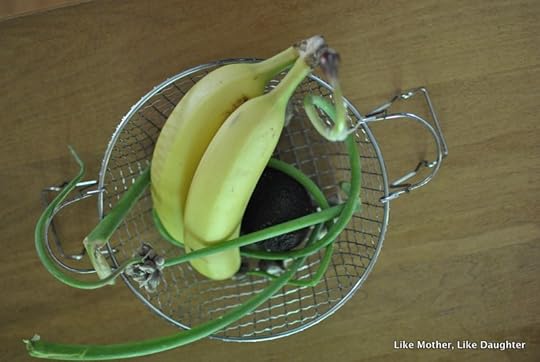

This summer has been amazing with its sunshine. However, for the garden, it’s been rough. Things feel a bit crispy out there, and I don’t know that I’m committed to watering to that extent.
The bunnies or something did a number — a total, complete number — on my beautiful beans. Crying. Maybe they will come back. I don’t know! I feel like in the past I’ve thrown up a little fencing in a completely half-baked way and that’s thwarted intruders. Not this time.


There should be mounds of zinnias, but they got those too.
The tomatoes are okay… but crispy.

Here is a sneak peek of one of the new bathrooms:


I hope to have a good tour for you very soon!
What’s going on with you?
The post Chatty. appeared first on Like Mother Like Daughter.
July 18, 2016
Read this, not that: Books about marriage.
Do you know this “eat this, not that” series of books? The idea is to help you make good choices in food and drink to avoid hidden calories that will tank your health. Well, Rosie had the thought that we could do something similar with books for the Library Project*.
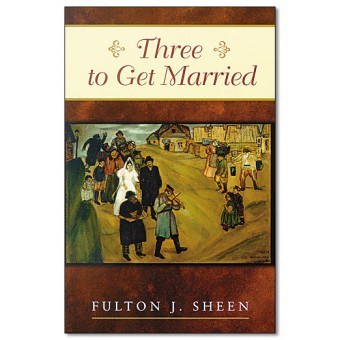
When you get married, you need to know a few things.
You need to know what marriage is, first of all! That’s tricky, because like most important concepts, one learns by living — in this case, ideally from growing up in a good, happy, fruitful, loving marriage — not any easy experience for many to come by. And then, it would be helpful to have the definition clearly stated, and even the best-intentioned books don’t do this.
I recently read the proofs of a book about marriage (the publisher was seeking a blurb from me) — about Catholic marriage — that did not mention that it is a sacrament! A whole book! No mention!
Even a book for non-Catholics needs to point out that marriage is a divinely instituted union between man and woman for a purpose greater than the two of them (see the first two chapters of Genesis), and that what God has so joined, man has the expectation of receiving His assistance for.
So don’t read those books.
You need some practical insight on how to become virtuous (hopefully, to continue to become virtuous, as virtue is not a project for marriage only). You need to know that people are different in how they express love and in how they feel inside, and that men are different from women, and vice versa. And often we need these books after the wedding, not having gotten the memo before.
Sometimes I see books that are about how to manipulate the other person, how to apply lessons learned from management experts, or how to get the most satisfaction from the other person. But marriage is a journey of sacrificial love, so in the end, those books aren’t going to help.
Don’t read those books.
You need wisdom, a commodity that is sorely lacking in today’s market, including in the marriage-advice category of the publishers’ offerings.
So I am going to give you a short list of wise books that I have found personally helpful and that have stood the test of time. They are good for marriage preparation, but they are also good for what I like to call “remote” preparation as well as for any marriage that could use a little remediation, as which of ours can’t?
To answer the question: What is Marriage?
I had often seen Fulton Sheen’s Three to Get Married, but had never read it. I guess I assumed it was a popularizing kind of book. Now that I’ve read it, I want to say that it’s excellent and by no means lightweight. Three to Get Married is basically the meat of Casti Connubii (On Chaste Marriage) presented in book form.
But it’s also very much a “theology of the body” or Christian anthropology — so much so that, as I was reading, I began to think that Saint John Paul II simply scooped up the important bits of this book and used them to work out his opus by that name. The key ideas to be found in John Paul’s works are already here (because they were already in Casti Connubii and thus, already in the long teachings of the Church, rooted in Scripture), but I would say, a bit easier to read!
Even so, if someone finds this tough going, it might help to begin on Chapter 18, The Dark Night of the Body, and read to the end, and then begin at the beginning. Or it might be a wonderful work of mercy for an older couple or two to host a reading group with those preparing for their wedding or recently married.
Did you know that the word matrimony means “making a mother”? I think that both the husband and wife would gain a lot from reading Pope John Paul’s Mulieris Dignitatem (On the Dignity and Vocation of Woman), as well as his exhortation, Familiaris Consortio (The Role of the Christian Family in the Modern World). Marriage is about making a family through the “unity of the two” as John Paul liked to call it.
I have a guided reading of both Casti Connubii and Mulieris Dignitatem here on the blog.
On the reasons for not using contraception, read Humanae Vitae (Of Human Life). I guarantee that any reader will be astonished to find that the teaching against contraception is not a capricious, arbitrary rule cooked up by some bitter old men, but simply emerges from the meaning of marriage itself. Anyone — not just Catholics — can follow the reasoning and come to the same conclusion.
I hope you appreciate just how many Vatican documents I want you to read!
Practical Wisdom.
Now, lots of marriage books are about just how to get along with each other. Once you know what marriage is, you need some practical wisdom on how to actually live together. I never really got that much help from any of the books out there except for these two really stellar ones:
The Temperament God Gave You. Many books make assumptions about how husband and wife will communicate and about what “meeting in the middle” or “meeting each other’s’ needs” might look like. But very, very few take into consideration a basic starting point, namely, each person’s temperament. Even a seemingly traditional sort of book like Father Lovasik’s Catholic Family Handbook assumes a lot about each spouse’s temperament, making it not that helpful if there is a significant deviation.
For instance, what if, far from being henpecked (common enough), the husband is so choleric that he just can’t let his wife do anything her own way? I feel that your usual book about marriage won’t even imagine this possibility. But if you have the tools to figure it out, namely, knowing that a certain kind of reaction goes along with a certain temperament, you can learn to live peaceably while striving to correct faults.
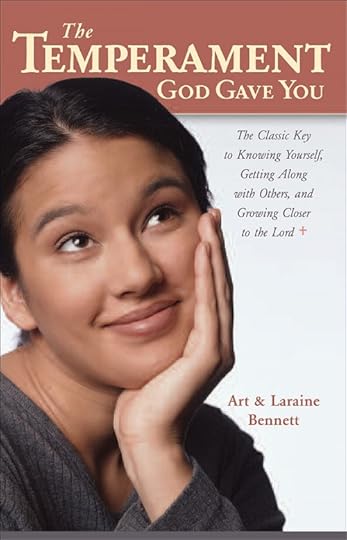
I actually think that this book is a good one to read long before you begin to date someone seriously. Knowing that people are not necessarily just like you in their reactions to things is huge — it really helps immeasurably to understand them — and to know if you are a good match, or perhaps why you are finding someone frustrating or opaque. Not that two particular temperaments can’t have a great marriage, but it’s good to know.
As I said to Suki, never in a million years would it have occurred to me that a person might prefer to approach a disagreement by retreating for a while to think about it. Before reading this book, I would have assumed that the person was acting with ill will.
Poor Chief.
The Five Love Languages. This book also really helps to understand yourself, which in turn helps you to understand what you are looking for from the other person. Where I think that the Temperament book is good well before marriage, I think this one might be good for afterwards, as well as in the marriage preparation phase.
People do have different ways of expressing love and affection — giving and receiving. After reading this book I don’t think it’s exhaustive, but you get the idea. I also think that it could make the point a bit more explicitly that you can’t change the “language” a person uses to express love, but you can accept the expression for how it’s intended. Sometimes this is actually the sacrifice God is asking us to make, and sometimes it’s the one that goes most against our own will.
We read it maybe 30 years into our (37-year-old) marriage, and I’d say that it did two things for us: First, it made it possible for us to simply say what we need to feel loved (“Please turn on the light on the porch for me if it gets dark and I’m not home yet” — me; and “Please say encouraging things to me at the end of the day” — him). But it also helped us to accept that the other is “saying” “I love you” in our own way, since that is always just going to continue as it has. It’s not that the person has to change completely — a little understanding goes such a long way!
For a nice vintage read on family life in general, as well as a chapter about very specific issues relating to the marriage act — but put in a respectful and loving way, very much in the context of the personhood of the two (and with no unsavory overtones so often found these days) — I recommend A Marriage Manual for Catholics, written by Catholic doctor and married man, William Lynch.
It’s only available used. It’s pretty old. But — if a couple is having technical problems, this is the book to go to. Just pay no attention to his diet advice, nor to the advice about breastfeeding, which is sadly typical of the time.
Instead, read Sheila Kippley’s Breastfeeding and Natural Child Spacing. Marriage is for making a family; having children is the goal of marriage. Having a child every year is not the norm if — IF — we shed our modern expectations of how taking care of an infant will go. This book explains how the natural act of nursing the baby will space the children for the vast majority of women. I consider this vital information for every engaged couple! Now, before you get yourself worked up, know that I have a host of nursing posts, so just go check those out, and also this one about how you might not end up with as many children as you feared, but children are good, and not to be feared! Remember: sometimes you just need a book about how things will probably go, not a book about each and every possibility.
Prayer.
When a friend asked me for a list of books to recommend to couples, I couldn’t help adding The Little Oratory: A Beginner’s Guide to Praying in the Home, written by yours truly and David Clayton, with added charming illustrations by Deirdre Folley (you know, Deirdre). Why? Because when you’re getting married, you might not know that you are setting up your own little “community of life and love and prayer” — but you are! You need a little visual expression of just that, and we help you make it. It’s a kind of “little prayer table kit” complete with beautiful icons, easily and inexpensively framed, as well as extensive instructions.
Praying together brings the Holy Spirit to help us in marriage and in everything!
*What is the Like Mother, Like Daughter Library Project?
The post Read this, not that: Books about marriage. appeared first on Like Mother Like Daughter.



